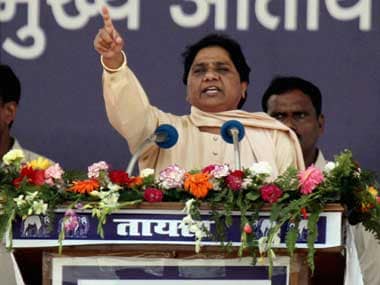In politics, like in cricket, one has to play to one’s strength. It requires a lot of sagacity and introspection to plug your weaknesses and fortify your defence. In Uttar Pradesh, the BJP has been throwing both time-tested tactics to the wind. The Bharatiya Janata Party’s (BJP) flirtation with caste-politics in the state is a clear indication that the party has not been playing to its strength. The party leadership’s inability lies in not realising that it has a cognitive deficiency in understanding the dynamics of castes in Uttar Pradesh – the country’s largest and politically most complex state. This is the precise reason why the BJP strategists are trying to pull wool over their own eyes and pretend that Dayashankar Singh’s scurrilous comments on Bahujan Samaj Party (BSP) chief Mayawati would lose steam sooner rather than later, and that the BJP would come out unscathed. In this assumption, they ignore the radical transformation that Uttar Pradesh has undergone in the past two decades. [caption id=“attachment_2728976” align=“alignleft” width=“380”]  File image of Bahujan Samaj Party Supremo Mayawati. PTI[/caption] Mayawati is not an ordinary Dalit leader. She cannot be treated like other fossilised Ambedkarites or turncoats like Ram Vilas Paswan. She is a cult-figure among the Dalits and a significant section of most backward classes — a stature she has attained not by accident but due to decades of careful planning and hard work. And this cult has promoted an army of followers whose devotion to Mayawati, and her cause, is unadulterated. She is not wide off the mark when she arrogates to herself the stature of a goddess for the Dalits. It might grate on the sensibilities of the elite but to her followers there is nothing amiss in that self-assessment. “People see me not just as Behen (sister) but as Devi (goddess).” She said it not boastfully, but matter-factly, suggesting how both she and her followers have easily internalised that image. But a pertinent question arises: How has she developed herself as such a larger-than-life personality? You do not need to go far to seek the answer. Visit monuments in the name of Periyar, Jhalkaribai, and several other icons, built around the ‘City of Nawabs’, Lucknow, and you will get the answer. Her project of building memorials in the name of fierce iconoclasts and Dalit heroes in the wake of the Babri mosque demolition was intended to weave a counter-narrative to Hindutva. That narrative found resonance among Dalits in UP. Along with her mentor, Kanshi Ram, Mayawati invented some heroes among Dalits to weave a history that was often at variance with the main narrative, and instilled a sense of pride among them. In fact, Mayawati emerged as the true representative of counter-culture in the state’s politics which changed the state’s social equilibrium forever. For traditional politicians, she may seem uncouth, indiscreet and not aligned to a set of elite etiquettes. But she is hardly bothered, and has developed her own style of elitism which is well-appreciated by her constituency. Take for example the manner in which she defended the money-collection on occasion of her birthday, in a Rajya Sabha debate. “We do not depend on big industrialists’ money, so we ask our workers to contribute,” she explained, taking a moral ground higher than any other national or regional party. The moment that Dayashankar Singh used the pejorative for her, she lapped it up like a deft politician and conveyed to her constituency the risk of going with a party like the BJP. She played up on the fear of Dalits’ losing the counter-narratives she had weaved all these years, to restore their pride in society. And she did it with superb political finesse, within hours of Dayashankar Singh’s indiscretion. Much before the BJP could fully comprehend the implication of any of it, Mayawati had completely outmanoeuvred the BJP, and established her supremacy. Mayawati was worried about the trend of a section of her support base gravitating towards the Hindutva fold back in the 2014 Lok Sabha elections. But the belief that this section has been weaned away from the BSP is quite misplaced. In reality, Modi’s emergence in 2014 produced a political narrative at the national level that overwhelmed smaller narratives in the state. Mayawati’s loss in 2014 was certainly not the BJP’s gain. What appears to be strange is the inability of the BJP leadership to learn from its 2014 experience. The party could have found traction among the electorate if it had strived to weave an alternative narrative for Uttar Pradesh. Instead, BJP president Amit Shah seems to be more eager to win over dubious caste leaders than believe in the fact established in 2014 that they command an overweening influence on their social groups. The tokenism of having meals with Dalits and mobilising Buddhists will be counter-productive — that kind of tokenism should be left for Rahul Gandhi. Dalits in UP have gone much beyond that symbolism and have occupied political power, not once but four-times in the past two decades. In the course of identity/caste politics, Mayawati’s prowess can be equally matched by Mulayam Singh Yadav and his Samajwadi Party. A seasoned Lohiaite, Yadav’s understanding of caste dynamics in UP is profound and pragmatic. He is known for setting caste equations that are like an impregnable political fort in Uttar Pradesh. Hemmed in by these two seasoned players of castes — Mayawati and Mulayam Singh — BJP president Amit Shah seems to be losing his narrative and is trying to imitate his intimate adversaries. This strategy came a cropper in the recent Bihar Assembly elections where two caste-politics veterans Nitish Kumar and Lalu Prasad outwitted the BJP. The BJP’s inability to play on its strengths in UP will cost it dearly in the upcoming Assembly elections.
Mayawati is not an ordinary Dalit leader, one who cannot be treated like other fossilised Ambedkarites or turncoats like Ram Vilas Paswan.
Advertisement
End of Article


)
)
)
)
)
)
)
)
)



